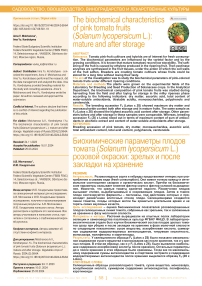The biochemical characteristics of pink tomato fruits (Solanum lycopersicum L.): mature and after storage
Автор: Molchanova A.V., Kondratyeva I.Yu.
Журнал: Овощи России @vegetables
Рубрика: Садоводство, овощеводство, виноградарство и лекарственные культуры
Статья в выпуске: 2 (76), 2024 года.
Бесплатный доступ
Relevance. Tomato pink-fruit cultivars and hybrids are of interest for fresh consumption. The biochemical parameters are influenced by the varietal factor and by the growing conditions. It is known that mature tomatoes record low storability. The softening of the fruit is caused by ethylene produced in the ripening fruit. Then pectinase enzymes are synthesized in the fruit tissues, under the action of which the cell walls of the fruit soften. Breeders are creating tomato cultivars whose fruits could be stored for a long time without losing their tasty. The aim of the investigation was to study the biochemical parameters of pink-colored tomato fruits under different ripening conditions.
Breeding accession of pink tomato, dry matter, monosaccharides, ascorbic acid, total antioxidant content, total acid content, polyphenols, carotenoids
Короткий адрес: https://sciup.org/140304494
IDR: 140304494 | УДК: 635.64:631.547.66:581.19 | DOI: 10.18619/2072-9146-2024-2-58-64
Текст научной статьи The biochemical characteristics of pink tomato fruits (Solanum lycopersicum L.): mature and after storage
Оригинальная статья / Original article УДК: 635.64:631.547.66:581.19
Поступила в редакцию: 24.11.2023
Принята к печати: 16.01.2024 Опубликована: 25.03.2024
Биохимические параметры плодов томата ( Solanum lycopersicum L.) розовой окраски: зрелых и после закладки на хранение
РЕЗЮМЕ
Актуальность. Розовоплодные сорта и гибриды представляют интерес при употреблении в свежем виде (fresh consumption). Они имеют тонкую кожицу и оптимальное соотношение сахаров и органических кислот. Причём на биохимические параметры оказывает влияние фактор сорта и фактор условий выращивания. Известно, что зрелые томаты хранятся недолго. Размягчение плодов вызывает этилен, вырабатываемый в созревающих плодах. Затем в тканях плода синтезируются ферменты – пектиназы, под действием которых и происходит размягчение клеточных стенок плода. Селекционерами создаются линии томатов, плоды которых могли бы храниться длительное время и не терять своих вкусовых качеств.
Цель исследования – оценка биохимических показателей розовоокрашенных плодов селекционных линий томата, собранные как зрелыми, так и заложенные на хранение в фазу молочной спелости.
Материалы и методы. Растения выращивали на опытных полях лаборатории селекции и семеноводства паслёновых культур ФГБНУ ФНЦО. В лабораторноаналитическом отделе был изучен биохимический состав плодов зрелых томатов сразу при уборке и после закладки на хранение в фазе молочной спелости по следующим показателям: сухое вещество, аскорбиновая кислота, суммарное содержания водорастворимых антиоксидантов, титруемая кислотность, моносахара, полифенолы и каротиноиды.
Результаты. У селекционного образца F 4 (Lotos x Z6) было показано максимальное содержание сухого вещества и моносахаров как после хранения, так и у зрелых плодов. В этом же образце, как и у F 5 (Lotos x Z6), было выявлено наибольшее содержание аскорбиновой кислоты после хранения. Остальные параметры до и после хранения в этих образцах были сравнимы. Тогда как по максимальному содержанию суммы антиоксидантов в спиртовом экстракте и содержанию водорастворимых антиоксидантов после хранения выделился образец F 6 (Z6 x Lotos).
ÏIntroduction
N owadays, both consumers and breeders pay attention to the quality of vegetable products. It is shown that the quality of tomato fruits is a combination of various organoleptic and nutritional characteristics: flavor characteristics are determined by the presence of dry matter, the ratio of monosaccharides content and titratable acidity and absolute acidity (pH of fruit pulp). In addition, the content of carotenoids and ascorbic acid, polyphenolic compounds as non-enzymatic antioxidants are important for human health [1; 2; 3; 4]. Numerous diverse studies have been carried out on tomato, both traditional morphological and biochemical analyses and new methods, such as Raman spectroscopy combined with chemometrics, used for phenotypic characterization of tomato genotypes. Genotypic differences in biochemical components such as carotenoids were confirmed using Raman spectroscopy. PCA results showed that yellow tomato mainly differed in carotenoids compared to others, while pink and dark tomato differed from yellow tomato in phenolic compounds, revealing the difference in antioxidant components that were obtained by biochemical analysis. In addition, the exocarp of pink, dark and yellow tomatoes differed in phenolic compounds, while the mesocarp and endocarp of yellow tomatoes differed in carotenoids [5; 6].
The use of diverse molecular, genetic and breeding methods and tools in the study of numerous tomato cultivars, hybrids and mutants with different fruit coloration leads to their new genotypes [7; 8; 9]. Breeding objectives aimed at improving pigments in tomato include accurate quantification of different pigments and the effect of environmental factors on these traits.
Special attention is paid to growing conditions and fruit storage factors, molecular, genetic and biochemical aspects that condition the quality of tomato fruit during ripening, storage and processing [10; 11; 12; 13]. Previously, we carried out work on the evaluation of biochemical parameters of tangerine tomatoes under different storage conditions [14], so in this work we analyzed the biochemical parameters of pink-fruited tomatoes grown in field conditions and stored.
Material and Methods
The material for the study was tomato breeding accessions (b.a.) with pink fruit coloration of the Laboratory of B reeding and Seed Production of Solanaceae crops of Federal Scientific Vegetable Center (Moscow region, Russia (55°39.51′ N, 37°12.23′ E)). In the presented results, the analysis of tomato b.a. for field condition of different generations, having dense fruits of pink color with good storability, taste qualities, which do not lose them during fruit ripening, was carried out. B.a. (Lotus x Z6) and (Z6 x Lotus) were obtained by using two parental lines of tomato in hybridization: Z6 – breeding from the Chinese collection sample, which has dense, storable, large pink fruits, but has an indeterminate bush and late ripening. Tomato cultivar for field conditions Lotus zoned for the NonChernozem zone of Russia. The cultivar is early-ripening, determinant bush, the fruits are large, pink, tasty, the fruit of tender consistency is not stored. New b.a. with pink large fruits, dense consistency with good storability, pleasant taste, medium-early maturity group, determinate bush (Table 1; Fig. 1, 2, 3, 4, 5).
Breeding accessions
F 4 (Lotos х Z6)
F 5 (Lotos х Z6)
F 6 (Lotos х Z6)
F 5 (Z6 х Lotos)
Table 1. Characteristics of pink-fruited tomato b.a.
Таблица 1. Характеристика розовоплодных линий томата
Characteristics of b.a.
Early ripening (93 days). The bush is ordinary, semi-spreading, the height of the main stem up to 70 cm. The fruit is rounded, light green without a spot at the stalk, pink when ripening, weighing up to 160 g. Fruits are dense.
Early ripening (89 days). The bush is half-stemmed, compact. The height of the main stem is up to 55 cm. The fruit is rounded, light green with a weak green spot at the stalk, pink when ripe. Fruit weight is 80-100 g. Fruits are dense.
Early ripening (93 days). The bush is determinate, ordinary. The fruit is rounded, light green without a spot at the peduncle, pink when ripening, weighing up to 200 g. Fruits are dense.
Early ripening (93 days). The bush is determinant, semi-stemmed. The fruit is rounded-flat, light green without a spot at the peduncle, pink when ripening, weighing up to 140 g. Fruits are dense.
Early ripening (93 days). The bush is determinant, half-stemmed. The fruit is rounded-flat, light green without a spot at the peduncle, pink at maturity, weighing up to 140 g. The fruit is dense.
F 6 (Z6 х Lotos)
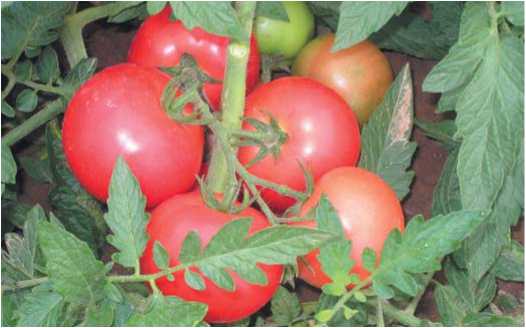
Рис. 1.Розовоплодный томат линия F 4 (Lotosх Z6)
Fig. 1.Pink-fruited tom ato breeding accession Line F 4 (Lotosх Z6)
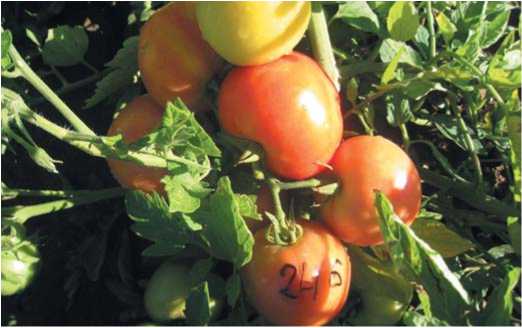
Рис.2.Розовоплодный томат линия F 5 (Lotosх Z6)
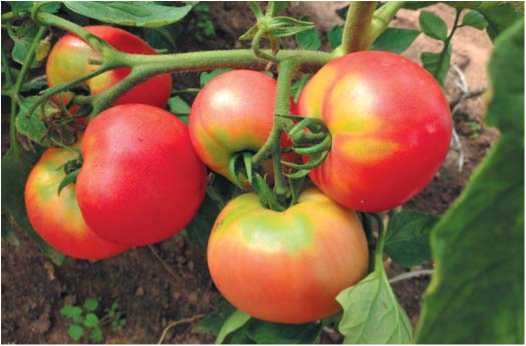
Рис.3.Розовоплодный томат линия F 6 (Lotosх Z6)
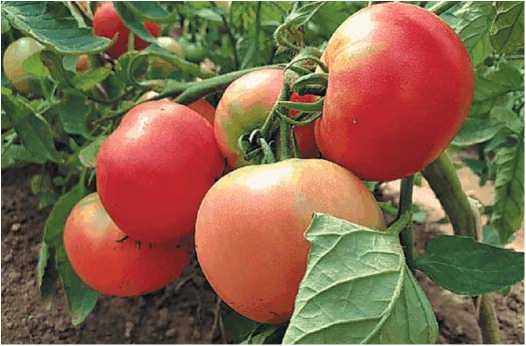
Рис.4.Розовоплодный томат линия F 5 (Z6х Lotos)
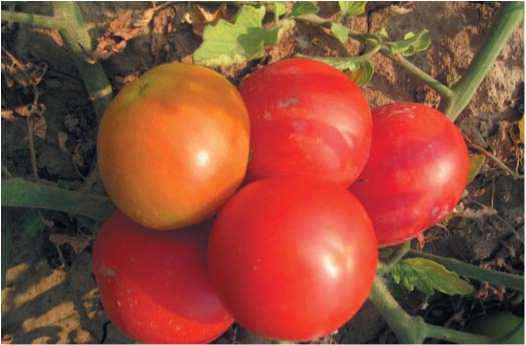
Рис.5.Розовоплодный томат линия F 6 (Z6 х Lotos)
Research was conducted in 2021 and 2022, from April to October, at the experimental fields of the institute, in a loam sod podzolic soil with the following characteristics: pH 6.2, 2.12% organic matter, 1.32 mg-eq 100 g-1 hydrolytic acidity, 18.5 mg kg-1 mineral nitrogen, 21.3 mg kg-1 ammonium nitrogen, sum of absorbed bases as much as 93.6%, 402 mg kg-1 mobile phosphorous, 198 mg kg-1 exchangeable potassium, 1 mg kg-1 S, 10.95 mg kg-1 Ca, 2.05 mg kg-1 Zn, 0.86 mg kg-1 B, 220 µg kg-1 d.w. Se, 7.65 mg kg-1 Ni, 0.22 mg kg-1 Cd, 1.6 mg kg-1 As, 12.85 mg kg-1 Pb.
The values of mean temperature and relative humidity during the vegetation period are presented in Table 2.
Table 2. Monthly temperature and precipitation in 2021 and 2022 Таблица 2. Температура и осадки в 2021 и 2022 годах по месяцам
|
Мл nth Month |
Temperature (°С) |
Precipitation (mm) |
|
2021 2022 |
2021 2022 |
|
May |
13.8 |
10.0 |
81 |
55.5 |
|
June |
21.8 |
18.6 |
20 |
24.6 |
|
July |
22.0 |
20.2 |
38 |
66.1 |
|
August |
19.4 |
22.3 |
36 |
13.7 |
|
September |
9.1 |
9.6 |
58 |
125.7 |
The seed sowing was performed on 25 April in cassettes (5x5 cm) and the seedling planting on 8 June according to a scheme 70 x 50 x 35 cm.
The first fertilization of seedlings with nitrogen-phospho-rus fertilizer (mass fraction of nitrogen 16%, P 2 O 5 – 16%, K 2 O – 16%) was conducted on 20 May, the second fertilization in the field on 16 June, light perching was conducted on 29 June. Field drenching was carried out once on June 30. Preventive treatment of plants against phytophthorosis was carried out twice – 13 July and 1 August (Ridomil Gold). Due to dry and hot weather in the second half of the growing season ripening of fruits was observed early, the weight of fruits was small. Field experiments, phenological observations, and yield accounting were conducted according to the Methodological Guidelines for the breeding of tomato cultivars and hybrids for fields and greenhouse [15].
Fruits were placed for ripening at the milk stage of maturity in plastic crates of 25x40 cm with openings on the entire surface of the walls. The ripening was carried out indoors, at room temperature not exceeding 18ºC. Fruits were placed visually healthy, without damage, harvested in dry weather. Fruits were placed in two layers, the boxes were not closed. The room was illuminated naturally. Counting and biochemical analysis was carried out after fruit ripening one week after storage.
The analysis of biochemical composition in fruits with pink coloring of fruits of b.a. was carried out in two stages – the first analysis immediately after harvesting, the second analysis of fruits harvested in the milky phase of maturity and stored for additional ripening.
The biochemical composition of tomato fruits of all variants of the experiment was studied according to the following parameters: determination of the total content of watersoluble antioxidants – according to the method of Maximova et al. [16], ascorbic acid (AA) was the external standard; AA content – according to the method of Sapozhnikova and Dorofeeva [17]. Dry matter content – by drying the sample to constant weight [18], titratable acidity was carried out according to Andryushchenko's method [19], monosaccharides content was carried out by cyanide method [20]. Taste index (Taste Index) was calculated according to Navez et al. [21] using the formula TI = TA + TS/(20 × TA), (where TA is titratable acidity, TS is sugar content).
The content of polyphenols was determined with a spectrophotometer using Folin-Ciocalteu reagent [17] in alcohol extracts of dried tomato fruits (70% ethanol, heating to 80 °C for 1 hour). Gallic acid was used as an external standard. The results were expressed in mg-eq. gallic acid/g dry weight.
The content of the sum of antioxidants was determined by titration of 1 ml of 0.05 N KMnO 4 solution in 0.24 M H 2 SO 4 medium with the analyzed solution (extract of dried tomato fruits in 70% alcohol) until the permanganate solution discolored [17]. Gallic acid was used as a standard [22]. The results were expressed in mg gallic acid eq/g dry weight.
Carotenoid composition was determined according to the following procedure. Before analysis, the fruits were washed, dried with filter paper and homogenized. From 0.5 to 1.5 g of the obtained mixture (depending on the brightness of fruit color) was extracted with acetone (3x5 ml), using glass powder for better extraction of carotenoids when rubbing the samples in a mortar. To the combined acetone extract, about 9 mL of hexane was added followed by 50-60 mL of distilled water. The aqueous layer was separated and washing of the organic layer with water was repeated 4-5 times until the acetone odor disappeared. The hexane layer thus obtained was quantitatively transferred to a 10 mL pycnometer, brought to the mark with hexane and filtered on a pleated filter through a layer of anhydrous sodium sulfate. The solution was stored without access to bright light and analyzed within 6 hours after preparation [23; 24].
The data were processed using analysis of variance and the separation of means was performed using Duncan's multiple range test, given a probability level of 0.05, using SPSS version 27 software.
The result of the test is a set of subsets of the mean, where in each subset the means are recognized as not differing significantly from each other.
Duncan's multiple interval test uses the step interval distribution to determine the critical values in comparing the means. Different comparisons between means may differ in their level of significance – because the level of significance depends on the size of the subset of the mean being considered. The Duncan's Multiple Range Test (DMRT) is a post hoc test to measure specific differences between pairs of averages [25].
Results and discussing
Pink-fruited tomato cultivars with dense fruits, good ripeness and tasty qualities were chosen from the collection breeding material.
Dry matter content is one of the most important indicators of tomato fruit quality and its suitability for processing [26]. Analysis of biochemical composition of pink-fruited tomato b.a. showed that the maximum content of dry matter and monosaccharides was in fruits of F 4 hybrids (Lotos x Z6) both in mature fruits and stored fruits – 9.17...9.78% and 4.67...4.85%, respectively (Fig. 6; A, B). Of the five hybrids studied, only fruits of hybrid F 5 (Z6 x Lotos) didn’t statistically differed dry matter content: stored fruits exceeded this index of mature fruits by 1.3 times (Fig. 6A).
The results we obtained for dry matter content in pink-fruited tomato samples correlated with the data of other researchers [27; 26].
Monosaccharides content in fruits of the other four hybrids was comparable – both before storage (2.573.95%) and after storing for ripening – 3.52-4.44% (Fig. 6 B), except for F 6 (Z6 x Lotos): 1.4 times the value of monosaccharides in stored fruits exceeded the value of mature fruits (6, B). Similar data were obtained by scientists from N.I. Vavilov All-Russian Institute of Plant Genetic Resources (VIR) on pink tomatoes, which fruits showed monosaccha-
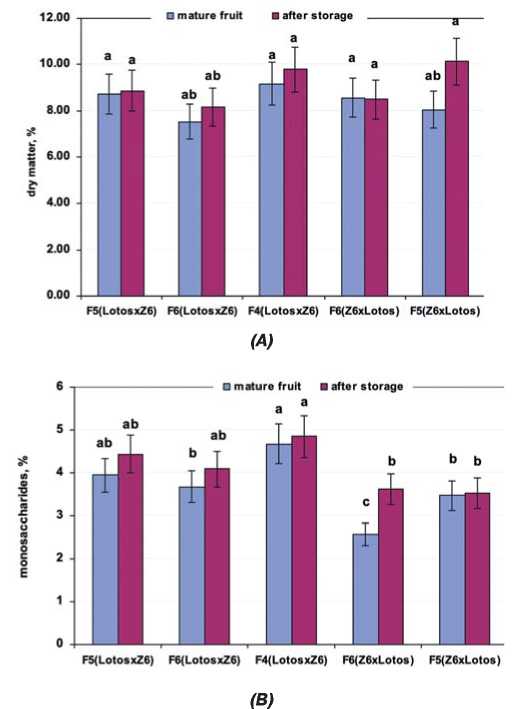
Fig. 6. Dry matter (A) and monosaccharides (B) content in pink-colored tomato fruits grown in field conditions. Values with the same letters are not statistically differentaccording to Duncan's test atp<0.05
Рис. 6. Содержание сухого вещества (A) и моносахаров (B) в розовоокрашенных плодах томатах, выращенных в условиях открытого грунта. Значения с одинаковыми буквами статистически не различаются согласно тесту Дункана при p<0.05
rides content of 1.47-5.35% (average 2.84%) with the maximum value in Superklusha cultivar [26].
In contrast to tangerine tomato fruits [14] which showed a high correlation coefficient (r=0.75), pink-colored tomatoes showed an average correlation coefficient between dry matter content and monosaccharides content – r=0.65 (Fig. 7).
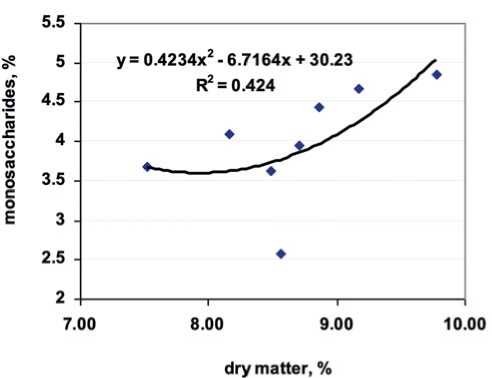
Fig. 7. Correlation relationship between the content of monosaccharides and dry matter in pink-colored tomato fruits (r=0.65;p<0.05)
Рис. 7. Корреляционная зависимость между содержанием моносахаров и сухого вещества в плодах томата розовой окраски (r=0.65;р<0.05)
Kurina et al. [26] also showed an average correlation coefficient between dry matter and monosaccharides content (r=0.40) on differently colored tomato fruits.
Titratable acidity in all tomato fruits harvested at maturity was comparable, 0.52-0.57% (malic acid). The tendency of exceeding this parameter in fruits stored in storage by 1.4 times was shown. The exception were the fruits of tomato b.a. F 5 (Lotus x Z6) and F 6 (Z6 x Lotus) in which this parameter did not differ significantly both in mature and stored fruits – 0.54-0.59% (Fig. 8).
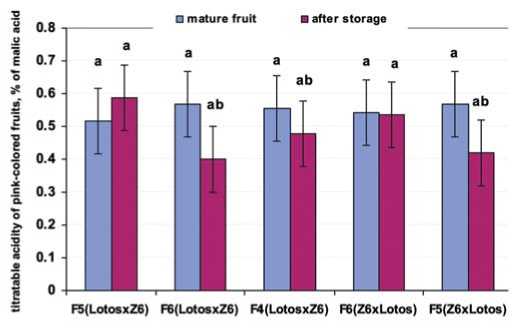
Fig. 8. Titratable acidity ofpink-colored fruits. Values with the same letters are notstatistically differentaccording to Duncan's testatp<0.05
Рис. 8. Титруемая кислотность розовоокрашенных плодах, выращенных в условиях открытого грунта.
Значения с одинаковыми буквами статистически не различаются согласно тесту Дункана при p<0.05
A comparable titratable acidity result of 0.58 % was obtained in tomato cultivar Pirotski rozni [6], and 0.40% acidity was observed in pink-fruited tomato cultivars Yaponskij tryufel' rozovyj and Bych'e serdce rozovoe [26].
The taste index calculated by us divided our samples into three groups (Table 3).
Table 3. Taste index of pink-colored tomato mature fruits and after storage Таблица 3. Вкусовые показатели зрелых розовых плодов томата и после хранения
|
Breeding accession |
Mature fruit |
After storage |
|
F 5 (Lotos х Z6) |
0.43 ab |
0.46 a |
|
F 6 (Lotos х Z6) |
0.44 ab |
0.37 b |
|
F 5 (Lotos х Z6) |
0.38 b |
0.43 ab |
|
F 5 (Z6 х Lotos) |
0.43 ab |
0.37 b |
|
F 6 (Z6 х Lotos) |
0.46 a |
0.47 a |
Values with the same letters are not statistically different according to Duncan's test at p<0.05
The Taste index was maximum in tomato b.a. of line F 6 (Z6 x Lotos) and F 5 (Lotos x Z6) harvested both mature and laid in storage – 0.43-0.47. Samples F 6 (Lotos x Z6) and F 5 (Z6 x Lotos) showed a 1.2 – fold decrease in the fruit tasty index, while b.a. F 5 (Lotos x Z6) showed a 1.2-fold increase in the taste index parameter during storage.
The ascorbic acid content in mature tomato fruits was comparable and ranged from 19.36 to 21.12 mg%, except for the sample F 6 (Lotos x Z6) in which the amount of ascorbic acid was 1.2-1.3 times lower than in the other b.a. (Fig. 9). The data we obtained on ascorbic acid content correlate with the data (the average result was 20.78 mg%) obtained on pink tomatoes [26]. In the work of Serbian researchers [6], ascorbic acid content in tomato fruits of Pirotski rozni cultivar is slightly lower than our samples – 17.83 mg%
The total content of water-soluble antioxidants in fruits harvested at maturity differed slightly: in b.a. F 5 (Lotus x Z6) and F 6 (Lotus x Z6), this parameter was 1.3 times higher than in other variants. In stored fruits, the maximum content of water-soluble antioxidants was determined in fruits of b.a. F 6 (Z6 x Lotus) – 1.4 times higher than in other variants (Fig. 9).
^H ascorbic acid, mg% —♦— total water-soluble AO content, mg AAE/g f.w.
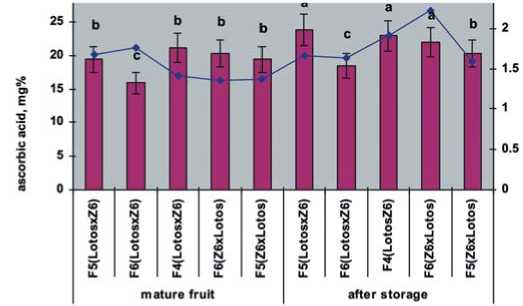
Fig. 9. Contentofascorbic acid and the sum ofwater-soluble antioxidants in pink-painted tomato fruits before and after storage. Values with the same letters are notstatistically different according to Duncan's testatp<0.05
Рис. 9. Содержание аскорбиновой кислоты и суммы водорастворимых антиоксидантов в розовоокрашенных плодах томата до и после закладки на хранение, выращенные в открытом грунте. Значения с одинаковыми буквами статистически не различаются согласно тесту Дункана при p<0.05
Unlike tangerine tomato fruits, which showed a high correlation coefficient – r=0.86 [14], in pink-colored tomatoes between the ascorbic acid content and the sum of watersoluble antioxidants also revealed a statistically insignificant correlation coefficient – r=0.44 (p>0.05).
Some tomato cultivars are characterized by pink color due to insufficient accumulation of naringenin chalcone and, as a consequence, transparent peel [28, 30]. Therefore, in our opinion, the determination of the content of polyphenols is a necessary indicator when analyzing the product quality.
The content of polyphenols in tomato fruits in all variants of the experiment was comparable and amounted to 19.08...22.69 mg GAE/g d.w. (Fig. 10). According to the sum of antioxidants, the b.a. were divided into two groups: three samples – F 6 (Lotos x Z6), F 6 (Z6 x Lotos), F 5 (Z6 x
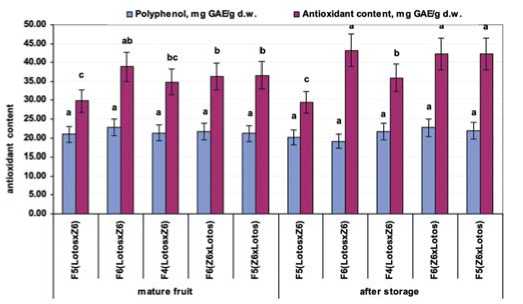
Fig. 10. Contents ofpolyphenols and antioxidants sum in alcohol extractin pink-colored tomato fruits grown in field conditions. Values with the same letters are notstatistically different according to Duncan's test atp<0.05
Рис. 10. Содержание полифенолов и суммы антиоксидантов в спиртовом экстракте (мг-экв Гк/г сух. мас.) в розовоокрашенных плодах томата, выращенных в условиях открытого грунта. Значения с одинаковыми буквами статистически не различаются согласно тесту Дункана при p<0.05
Lotos) – after storage exceeded the antioxidant parameter of mature fruits by 1.2 times, whereas the parameters of two samples – F 5 (Lotos x Z6) and F 4 (Lotos x Z6) b.a. were comparable both analyzed mature and put in storage – 29.42-29.77 and 34.82-35.91 mg GAE/g d.w.
The correlation coefficient between the content of polyphenols and the sum of antioxidants in pink-colored tomato fruits was slightly lower than in tangerine-colored fruits – r=0.85 (Fig. 11).
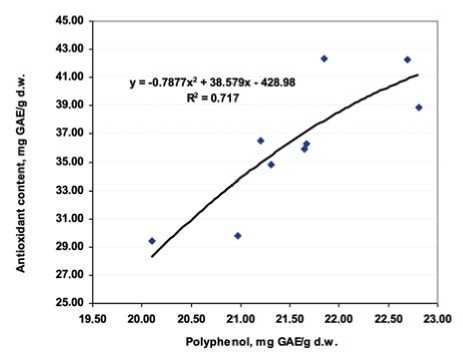
Fig. 11. Correlation relationship between polyphenol content and sum ofantioxidants in pink tomato fruits (r=0.85;p<0.02) Рис. 11. Корреляционная зависимость между содержанием полифенолов и суммой антиоксидантов в плодах томата розовой окраски (r=0.85;p<0.02)
Tomato fruit color/coloration is the most important component of product quality demanded by the market and consumers. Improved fruit coloration (carotenoid composition and chalcone content) has been directly linked by the researchers to increased nutritional and functional value of tomato [28].
The total carotenoid content in mature tomato fruits differed significantly (Fig. 12). The highest value was found in sample F 5 (Lotos x Z6) – 12.46 mg/g. The content of carotenoids in other variants was significantly lower by 1.41.9 times.
In stored tomato samples, the carotenoid content in all samples was comparable and was in the range of 7.53-9.62 mg/g, with the exception of b.a. F 6 (Lotos x Z6) in the fruits of which the carotenoid amount was minimal – 5.45 mg/g (Fig. 12).
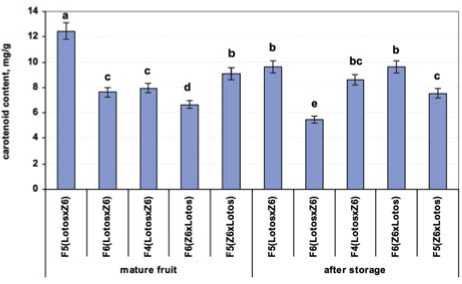
Fig. 12. Total carotenoid content in pink-colored tom ato fruits grown in field conditions. Values with the same letters are not statistically differentaccording to Duncan's testatp<0.05 Рис. 12. Содержание каротиноидов в плодах томата розовой окраски, выращенных в условиях открытого грунта. Значения с одинаковыми буквами статистически не различаются согласно тесту Дункана при p<0.05
In the comparative analysis the breeding accessions were divided into three groups: in the fruits of one sample – F 4 (Lotos x Z6) the sum of carotenoids was comparable and was in the range of 7.95-8.61 mg/g, in sample F 6 (Lotos x Z6) the sum of carotenoids increased significantly after storage in comparison with mature tomatoes by 1.5 times. In three breeding accessions, the sum of carotenoids after storage decreased significantly by 1.2-1.4 times compared to the analyzed mature fruits.
Список литературы The biochemical characteristics of pink tomato fruits (Solanum lycopersicum L.): mature and after storage
- The Tomato Genome Consortium. The tomato genome sequences provides insights into fleshy fruit evolution. Nature. 2012;(485):635-641. https://doi.org/10.1038/nature11119.
- Tieman D., Zhu G., Resende M.F.R. Jr., Lin T., Nguyen C., Bies D., Rambla J.L., Beltran K., Taylor M., Zhang B., Ikeda H., Liu Z., Fisher J., Zemach I., Monforte A., Zamir D., Granell A., Kirst M., Huang S., Klee H. A chemical genetic roadmap to improved tomato flavor. Science. 2017;(355):391-394. https://doi.org/10.1126/science.aal1556.
- Mata-Nicolas E., Montero-Pau J., Gimeno-Paez E., Garsia-Carpinero V., Ziarsolo P., Menda N., Mueller L.K., Blanca J., Caňizares J., van der Knaap E., Diez M.J. Exploiting the diversity of tomato: the development of a phenotypicalyy and genetically detailed germplasm collection. Horticulture Research. 2020;7:66. https://doi.org/10.1038/s41438-020-0291-7.
- Rosa-Martínez E., Bovy A., Plazas M., Tikunov Y., Prohens J., Pereira-Dias L. Genetics and breeding of phenolic content in tomato, eggplant and pepper fruits. Front Plant Sciences. 2023;14:1135237. https://doi.org/10.3389/fpls.2023.1135237.
- Alonge M., Wang X., Benoit M., Soyk S., Pereira L., Zhang L., Suresh H., Ramakrishnan S., Maumus F., Ciren D., Levy Y., Hai Harel T., Shalev-Schlosser G., Amsellem Z., Razifard H., Caicedo A.L., Tieman D.M., Klee H., Kirsche M., Aganezov S., Ranallo-Benavidez T.R., Lemmon Z.H., Kim J., Robitaille G., Kramer M., Goodwin S., McCombie W.R., Hutton S., Van Eck J., Gillis J., Eshed Y., Sedlazeck F.J., van der Knaap E., Schatz M.C., Lippman Z.B. Major impacts of widespread structural variation on gene expression and crop improvement in tomato. Cell. 2020;182:145-161. https://doi.org/10.1016/j.cell.2020.05.021.
- Petrović I., Marjanović M., Pećinar I., Savić S., Jovanović Z., Stikić R. Chemical Characterization of Different Colored Tomatoes: Application of Biochemical and Spectroscopic Tools. Biol. Life Sci. Forum. 2022;16(1):32. https://doi.org/10.3390/IECHo2022-12482.
- Fernandez-Moreno J.-P., Tzfadia O., Forment J., Presa S., Rogachev I., Meir S., Orzaez D., Aharoni A., Granell A. Characterization of a New Pink-Fruited Tomato Mutant Results in the Identification of a Null Allele of the SlMYB12 Transcription Factor. Plant Physiology. 2016;171(3):1821-1836. https://doi.org/10.1104/pp.16.00282.
- Kang S.-I., Hwang I., Goswami G., Jung H.-J., Kumar N. U., Yoo H.-J., Lee J. M., Nou I. S. Molecular Insights Reveal Psy1, SGR, and SlMYB12 Genes are Associated with Diverse Fruit Color Pigments in Tomato (Solanum lycopersicum L.). Molecules. 2017;22(12):2180. https://doi.org/10.3390/molecules22122180.
- Chattopadhyay T., Hazra P., Akhtar S., Maurya D., Mukherjee A., Roy S. Skin colour, carotenogenesis and chlorophyll degradation mutant alleles: genetic orchestration behind the fruit colour variation in tomato. Plant Cell Rep. 2021May;40(5):767-782. https://doi.org/10.1007/s00299-020-02650-9.
- Ballester A.-R., Molthoff J., de Vos R., Hekkert B.T., Orzaez D., Fernández-Moreno J.-P., Tripodi P., Grandillo S., Martin C., Heldens J., Ykema M., Granell A., Bovy A. Biochemical and molecular analysis of pink tomatoes: deregulated expression of the gene encoding transcription factor SlMYB12 leads to pink tomato fruit color. Plant Physiol. 2010Jan;152(1):71-84. https://doi.org/10.1104/pp.109.147322.
- Szuvandzsiev P., Helyes L., Lugasi A., Szanto C., Baranowski P., Pek Z. Estimation of antioxidant components of tomato using VIS-NIP reflectance data by handheld portable spectrometer. International Agrophysics. 2014;28:521-527. https://doi.org/10.2478/intag-2014-0042.
- Shan S., Wang Z., Pu H., Duan W., Song H., Li J., Zhang Z., Xu X. DNA methylation mediated by melatonin was involved in ethylene signal transmission and ripening of tomato fruit. Scientia Horticulturae. 2022;(291):110566. https://doi.org/10.21203/rs.3.rs-180786/v1.
- Zhu F., Wen W., Cheng Y., Fernie A. R. The metabolic changes that effect fruit quality during tomato fruit ripening. Molecular Horticulture. 2022;(2):2. https://doi.org/10.1186/s43897-022-00024-1.
- Kondratyeva I.Yu., Molchanova A.V. Effect of ripening on biochemical characteristics of tangerine tomatoes (Solanum lycopersicum L.). Vegetables crops of Russia. 2022;(6):72-78. https://doi.org/10.18619/2072-9146-2022-6-72-78. EDN: SASVDC.
- Guidelines for the breeding of cultivars and hybrids of tomato for fields and greenhouse. Moscow. 1986. [in Russ.]
- Maximova T.V., Nikulina I.N., Pakhomov V.P., Shkarina E.I., Chumakova Z.V., Arzamastsev A.P. Method for determination of antioxidant activity. Description of the invention for the patent of the Russian Federation. М. 2001. RU2170930 С1. [in Russ.].
- Golubkina N.A., Kekina E.G., Molchanova A.V., Antoshkina M.S., Nadezhkin S.M., Soldatenko A.V. Antioxidants of plants and methods for their determination. Moscow, 2020. Infra-M. [in Russ.].
- Ermakov A.I., Arasimovich V.V., Yarosch N.P., Peruansky U.A., Lukovnikova G.A., Ikonnikova M.I. Methods of biochemical research. L., Agropromizdat. 1987; 430. [in Russ.].
- Andryushchenko V.K. Methods of optimization of biochemical selection of vegetable crops. Kishinev, "Stiinza". 1981;30-34. [in Russ.].
- Determination of sugars in vegetables, berries and fruits. Cyanide method of determination of sugars in plants. Practicum on agrochemistry, ed. by V.V. Kidin. Moscow, publishing house "Kolos". 2008;236-240. [in Russ.].
- Navez B.; Letard M.; Graselly D.; Jost J. Tomatoes: criteria for quality. Infos CTIFL. 1999;(155):41-47.
- Misin V.M., Klimenko I.V., Zhuravleva T.S. On the suitability of gallic acid as a standard for an antioxidant formulation. Competency (Russia). 2014;7(118):46-51. EDN: SNHHYF. [in Russ.].
- Rodriguez-Amaya D.B. A guide to carotenoid analysis in foods. 2001, Washington, OMNI Research. 65.
- Golubkina N.A., Mоlchanova A.V., Tareeva M.M., Baback O.G., Nekrashevich N.A., Kondratyeva I.Yu. Quantitative thing layer chromatography for evaluation of carotenoid composition of tomatoes Solanum lycopersicum. Vegetable crops of Russia. 2017;(5):96-99. (In Russ.) https://doi.org/10.18619/2072-9146-2017-5-96-99. EDN: ORXRVH.
- Glen S. "Duncan’s Multiple Range Test (MRT)". StatisticsHowTo.com: Elementary Statistics for the rest of us! 2023. https://www.statisticshowto.com/duncans-multiple-range-test.
- Kurina A.B., Solovieva A.E., Khrapalova I.A., Artemyeva A.M. Biochemical composition of tomato fruits of various colors. Vavilov journal of genetics and breeding. 2021;25(5):514-527. https://doi.org/10.18699/VJ21.058. EDN: MQKXGF.
- Ignatova S.I., Babak O.G., Bagirova S.F. Development of high-lycopene tomato hybrids using conventional breeding techniques and molecular markers. Vegetable crops of Russia. 2020;(5):22-28. (In Russ.) https://doi.org/10.18619/2072-9146-2020-5-22-28. EDN: AVQFUJ.
- Marti R., Rosello S., Cebolla-Cornejo J. Tomato as a source of carotenoids and polyphenols targeted to cancer prevention. Cancers. 2016;(8):58. https://doi.org/10.3390/cancers8060058.
- Batziakas K.G., Singh S., Stanley H., Brecht J.K., Rivard C.L., Pliakoni E.D. An innovative approach for maintaining the quality of pink tomatoes stored at optimum and above-optimum temperatures using a microporous membrane patch. Food Packaging and Shelf Life. 2022;(34):100981. https://doi.org/10.1016/j.fpsl.2022.100981.
- Anton D., Bender I., Kaart T., Roasto M., Heinon M., Luik A., Püssa T. Changes in polyphenols contents and antioxidant capacities of organically and conventionally cultivated tomato (Solanum lycopersicum L.) fruits during ripening. International Journal of Analytical Chemistry. 2017;(10):2367453. https://doi.org/10.1155/2017/2367453.

